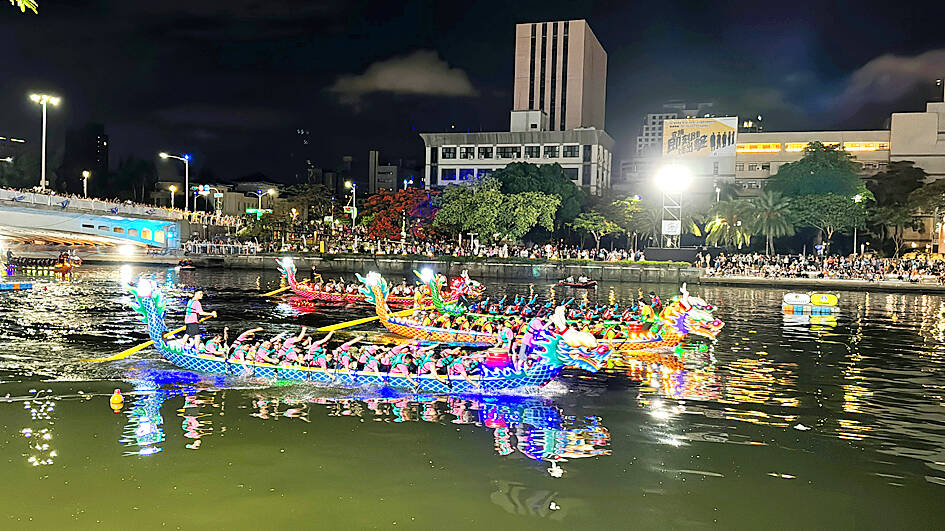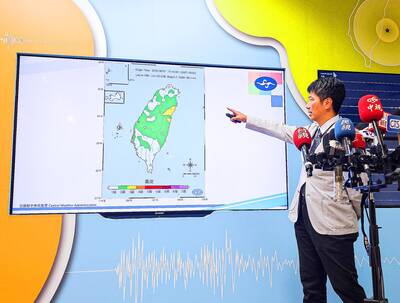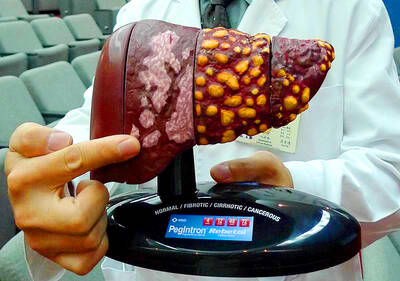Across the Chinese diaspora, racing in dragon boats has been a tradition reaching back thousands of years.
However, change is afoot, most recently in central Taiwan where the races were switched to the evening to take advantage of cooler temperatures, a refreshing breeze and the sight of the boats lit up with LED lights running the length of the low-lying watercraft.
A drummer pounds out a rhythm behind the elaborately carved dragon head in the bow, while a navigator sits in the stern, where a tail rises to complete the look of the mythical animal, a traditional Chinese harbinger of prosperity and good luck.

Photo: Hsu Li-chuan, Taipei Times
It is mainly an amateur sport and crews are formed among groups of neighbors and coworkers.
Emily Lin, 31, who works as a sales executive in Changhua County, said that training sessions at a local junior-high school were an excellent way to strengthen friendships outside of work.
“This dragon boat race allows us to meet, exchange and take part in something,” Lin said yesterday following qualifiers the previous night.
Daytime racing means dealing with the intense central Taiwan sun reflecting off the river, leaving you feeling unwell, said Chen Ta-tzung, a 28-year-old machinery maintenance specialist.
“But in the evening, you don’t have the sun,” Chen said, adding that a bit of a breeze makes everything easier than during the day.
“When we focus on rowing during the race, we cannot enjoy the beautiful scene, but when we row back, we can really enjoy the beautiful sights,” he said.
This year’s races hold a special meaning for many participants and spectators as they are the first after a three-year break because of the COVID-19 pandemic.
The sizes of the boats vary and the numbers of rowers can range from 10 to 20 or more. The festival generally falls at the start of June based around the summer solstice according to the lunar calendar.
Over the past few decades, the sport has spread in popularity around the world and standards have been imposed on rules and equipment, including the size of paddles and requirements that the drummer, playing a similar role to the coxswain in college and Olympic rowing, maintains a constant beat.
“Racing at night is special for rowers,” said Huang Yi-kai, 21, who is a coach for stand-up paddleboard rowers. “This allowed rowers to focus on the moment. It’s a refreshing experience.”
Dragon boat races are also being held in Hong Kong and Macau, as well as around China, where lax safety standards have occasionally led to deadly accidents.

The Taipei Summer Festival is to begin tomorrow at Dadaocheng Wharf (大稻埕), featuring four themed firework shows and five live music performances throughout the month, the Taipei Department of Information and Tourism said today. The festival in the city’s Datong District (大同) is to run until Aug. 30, holding firework displays on Wednesdays and the final Saturday of the event. The first show is scheduled for tomorrow, followed by Aug. 13, 20 and 30. To celebrate the 30th anniversary of Disney Pixar's movie Toy Story, the festival has partnered with Walt Disney Co (Taiwan) to host a special themed area on

Aftershocks from a magnitude 6.2 earthquake that struck off Yilan County at 3:45pm yesterday could reach a magnitude of 5 to 5.5, the Central Weather Administration (CWA) said. Seismological Center technical officer Chiu Chun-ta (邱俊達) told a news conference that the epicenter of the temblor was more than 100km from Taiwan. Although predicted to measure between magnitude 5 and 5.5, the aftershocks would reach an intensity of 1 on Taiwan’s 7-tier scale, which gauges the actual effect of an earthquake, he said. The earthquake lasted longer in Taipei because the city is in a basin, he said. The quake’s epicenter was about 128.9km east-southeast

BE CAREFUL: The virus rarely causes severe illness or death, but newborns, older people and those with medical conditions are at risk of more severe illness As more than 7,000 cases of chikungunya fever have been reported in China’s Guangdong Province this year, including 2,892 new cases last week, the Centers for Disease Control (CDC) yesterday said it is monitoring the situation and considering raising the travel notice level, which might be announced today. The CDC issued a level 1 travel notice, or “watch,” for Guangdong Province on July 22, citing an outbreak in Foshan, a manufacturing hub in the south of the province, that was reported early last month. Between July 27 and Saturday, the province reported 2,892 new cases of chikungunya, reaching a total of 7,716

STAY VIGILANT: People should reduce the risk of chronic liver inflammation by avoiding excessive alcohol consumption, smoking and eating pickled foods, the physician said A doctor last week urged people to look for five key warning signs of acute liver failure after popular producer-turned-entertainer Shen Yu-lin (沈玉琳) was reportedly admitted to an intensive care unit for fulminant hepatitis. Fulminant hepatitis is the rapid and massive death of liver cells, impairing the organ’s detoxification, metabolic, protein synthesis and bile production functions, which if left untreated has a mortality rate as high as 80 percent, according to the Web site of Advancing Clinical Treatment of Liver Disease, an international organization focused on liver disease prevention and treatment. People with hepatitis B or C are at higher risk of